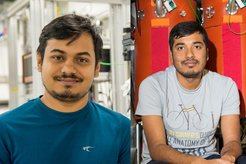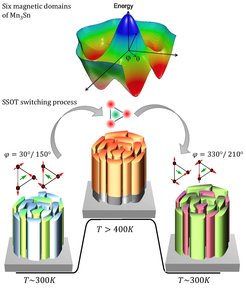Switching of chiral antiferromagnetic films: a new mechanism is proposed
Scientists from the Max Planck Institute of Microstructure Physics found a new mechanism to a novel method of manipulating the ground state of a special class of antiferromagnetic thin films with chiral magnetic ground states.
Spintronics is a field of research that focusses on the generation of spin currents and the applications of such spin currents to allow for the manipulation of different magnetic states representing “0”s and “1”s in storage technologies. Whilst the manipulation of the magnetic states of ferromagnet/ferrimagnetic thin film materials is well established, the possibility of using spin currents to set the magnetic structure of materials that have no net magnetic moment, namely antiferromagnets is in its infancy.

In a paper published in Science Advances on June 16th a group of scientists in the NISE department (Nanosystems formed from Ions, Spins and Electrons) directed by Stuart Parkin at the Max Planck Institute of Microstructure Physics, Halle and in a collaboration with Ingrid Mertig’s group at the Martin Luther University, Halle, report a novel method of manipulating the ground state of a special class of antiferromagnetic thin films with chiral magnetic ground states. These scientists show that the antiferromagnetic ground state can be set by electrical current pulses as short as 10 nanoseconds in the presence of small magnetic fields. The combination of single current pulses and magnetic field allows for a succession of different ground states to be accessed.

(bottom panel) Different stages of the switching of Mn3Sn with seeded spin-orbit torque.
Furthermore, the current pulse is shown to serve two purposes. On the one hand the current heats the film to above its magnetic ordering temperature and, on the other hand, the current that is passed through a thin layer in proximity to the chiral antiferromagnetic layer allows, via a spin Hall effect, for the conversion of the electrical current to a spin current that sets the magnetic structure of just a thin interface layer within the antiferromagnet layer. Provided that the current pulse is switched off slowly enough, compared to the rate at which the antiferromagnet cools down, the scientists show that the magnetic structure of the interface layer determined by the spin current then “seeds” the magnetic structure of the entire layer. This mechanism allows for the magnetic structure of even very thick layers of the antiferromagnet to be manipulated. The thicker the magnetic layer the greater is the thermal stability of nanoscopic devices formed from the antiferromagnetic material. Stuart Parkin comments that “Our new insights into the current induced switching of chiral antiferromagnetic layers have very important ramifications for future spintronic devices based on these highly interesting materials”.
This work was published on June 15, 2022 in Science Advances (Pal, B. et al. Setting of the magnetic structure of chiral kagome antiferromagnets by a seeded spin-orbit torque. Sci. Adv. 8, eabo5930 (2022)).













